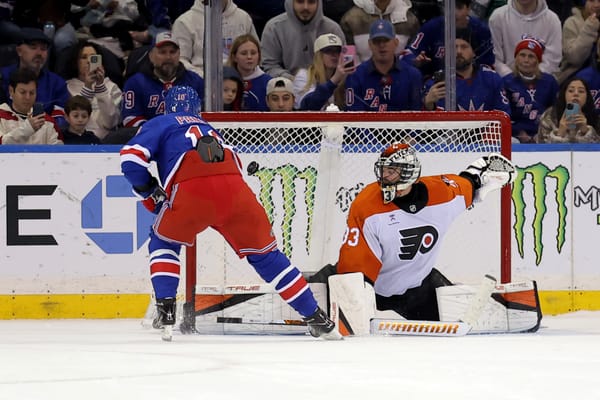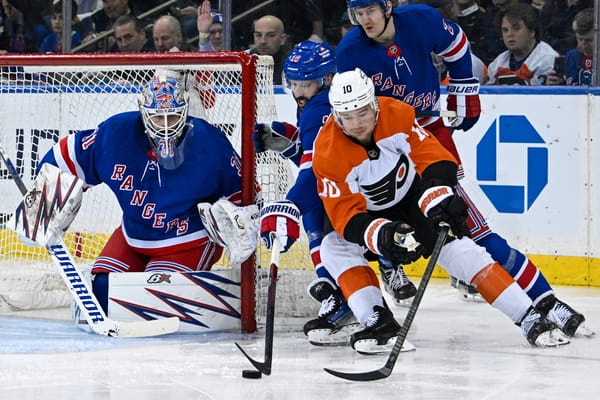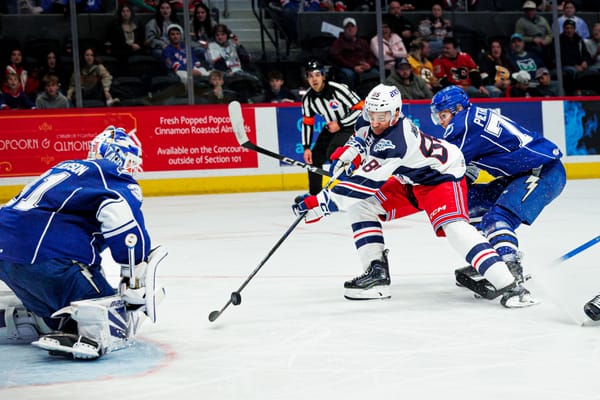Blueshirt Banter 2019 New York Rangers Prospect Rankings: 5-1
5. Adam Fox, Right Defense
2018 Ranking: N/A
Age: 21
Acquired Via: Trade (2019)
This is mostly a copy-and-paste of my scouting report on Fox from back in May.
Fox has been an offensive defenseman throughout his entire amateur career, and that will continue to be his identity in pro hockey. He doesn’t possess many physical gifts. His skating is just okay. His shot is average. Instead, he makes offense happen with his brain.
Fox’s forte is knowing when to move the puck in a flash versus when to hold onto it and wait for lanes to open up. He’s not going to dice through the neutral zone and blaze past defenders with the puck, but instead will find the right forward outlets to spring plays forward.
Within the offensive zone, Fox is a player you want with the puck on his stick. He does an exceptional job of opening up his hips along the blue line and dragging the high forwards with him, thereby affecting the opposition’s structure and creating passing and shooting options.
He’s aggressive, jumping up the ice when he sees transition opportunities and activating low on offensive-zone possessions. He scores his goals not with blasts from the blue line, but rather sneaky movement towards the circles and high slot.
These skills have certainly translated into production for Fox both at the college and international levels. As a Freshman, Fox registered 40 points in 35 games. That’s the highest points-per-game average among under-19 defensemen in the last 20 seasons.
Last season, Fox hit 1.45 points-per-game, which is the highest mark by an NCAA defenseman since 1995. It’s important to note that the ECAC — the conference in which Harvard plays — isn’t particularly strong, so his numbers are skewed compared to players in other conferences. Nonetheless, that is remarkable production on his part and certainly justifies a high offensive ceiling.
There are downsides to Fox’s game, but none that are unmitigated. At 5’10 and roughly 180 pounds, he is undersized. He’s not someone you want in board battles against big players nor is he going to be the one to clear power forwards out of the slot. His skating is merely average, which limits him both offensively and defensively. Fox will do fine in keeping up with the play, but he lacks the speed to put defenders on their heels or win puck races against speedy wingers. However, he does work hard, and I’ve seen him recover on opposition transition rushes because of that relentlessness. He also relies on his brain defensively to make reads at the blue line to seal gaps or cut off passes.
I hesitate to call Fox a blue-chip prospect because I don’t think he is, and based on the circumstances I can see the hype train picking up too much speed. However, it should be noted that Fox does bring something to the table that the Rangers sorely need. Prospects like K’Andre Miller and Nils Lundkvist have major upside but are still years away from theoretically putting it all together. Others, like Libor Hajek and Joey Keane, are pretty polished, but they do not realistically project as high-caliber defensemen. Tony DeAngelo is a total Wild Card whose status changes on a day-to-day basis. Fox not only has the ability to be an impact player, but is close to a finished product.
Fox seems poised to make the Rangers out of training camp, but the team’s depth chart is still a mystery as we wait see to how the Rangers address their current salary cap over-expenditure. A Shattenkirk departure would more or less clear the path for Fox, whereas his presence otherwise complicates it.
4. Igor Shesterkin, Goaltender
2018 Ranking: 4
Age: 23
Acquired Via: 2014 Draft (Fourth Round)
I’m going to level with you. There’s nothing particularly interesting for me to say about Shesterkin that hasn’t already been said in the last five years. Once again, he split duties in goal for SKA, the best non-NHL team in the world. In 28 games, he posted a career-high .953 save percentage and an absurd 10 shutouts. He finished the season with a 24-4-0 record. Absolute domination.
He did falter in the playoffs, but look: This is a goaltender who has played exceptionally well for SKA over the last three seasons, and who looked extremely bored in Russia’s minor leagues the previous two seasons.
Quite frankly, I’m excited that he has signed with the Rangers just so we’ll have new things to say about him, or maybe even remove him from this list altogether. In all seriousness, though, this test has been a long time coming. I’m not going to go as far as to say that Shesterkin was wasting away, but he had proven everything he needed to in Russia well prior to his signing with the Rangers. This is going to be an important test for him. First, can he challenge Alexandar Georgiev for the backup spot in New York? If not, or if he’s sent down as a matter of procedure, how will he fair in Hartford? Sure, there are culture changes to worry about, and a different style of play to adapt to. More than anything, though, I am eager to see how Shesterkin fairs on a team that isn’t blowing away the competition every night, In fact, whether in Hartford or New York, he’s going to be asked to do some heavy lifting.
I think Shesterkin represents the most exciting project that Benoit Allaire will get his hands on with the Rangers. He is an extremely athletic goaltender who tracks the puck well and keeps on his edges. Now, it’s up to Allaire to fine-tune his game. Shesterkin likes to be aggressive, while Allaire teaches his goaltenders to stay farther back in the crease. How do they find a balance together? How open will Shesterkin be to change? I imagine it will go well, but it’s still worth asking the questions.
Shesterkin has been a fixture in the 3-5 spots in my rankings, which represents general uncertainty surrounding goaltenders more than anything else. Any plausible deniability about him not being a top goaltending prospect has been exterminated 20 times over in the last two seasons. Just how good can he become? The answer to that is going to single-handedly change the team’s entire blueprint for the next decade.
3. K’Andre Miller, Left Defense
2018 Ranking: 6
Age: 19
Acquired Via: 2018 Draft (First Round)
When the Rangers traded up (rather aggressively) in the 2018 NHL Draft to grab Miller, there was no doubting that they had just acquired a high-upside player. Our draft profile concluded with this thought:
“If he can learn to properly utilize his athleticism and size, he could turn into a scary player with rare ability.”
However, as I admitted in December, I hadn’t even fantasized about Miller realizing his potential right away as a freshman in the NCAA.
Not so surprising was that Miller’s defensive game translated immediately. He’s 6’5 and already has a man’s strength. He skates like the wind. He has a long reach and is not afraid to dish out physical punishment. That’s a hell of a foundation for a shutdown defenseman. I love these two clips where Miller (#19 on Wisconsin) straight up bullies guys. In the first clip in particular, he’s moving a player out of his goalie’s line of sight with the ease of luggage on wheels.
I was far less confident that he would be an offensive difference maker right away. Miller is an explosive skater who has the presence of a freight train when he’s carrying the puck through open ice. But in the USHL ability to impact the game on controlled offensive zone possessions was limited.
At Wisconsin, though, that part of his game really showed up. He now has a lot of snap behind his wrist shot. Quite a few times he beat goaltenders clean from distance simply because there was so much velocity on the puck. He’s done well to combine his physical strength with technique to develop a dangerous shot.
I was also impressed with his playmaking. No, he’s ever going to be a #1 PP QB, but he displayed creative passing ability. He became a lot more active in the play as well. In hindsight perhaps his tepidity in the offensive zone with the US National Development Program was really him deferring to that team’s wealth of offensive superstars rather than a referendum on his ability. On a barren Wisconsin team that badly needed someone to step up and make plays, Miller did so.
The only blemish on his Freshman season was a leg injury in March that sidelined him for the remainder of the season. Without those missed 10 games, Miller almost certainly leads Wisconsin in points; a remarkable feat for a freshman defenseman.
By points-per-game, Miller finished second among all Big-Ten defensemen in points-per-game; only bluechip prospect Quinn Hughes finished higher. In fact, over the last 20 NCAA seasons, Miller ranks eighth among all defensemen in their Draft-Plus-1 seasons by points-per-game. Tied with Justin Faulk and ahead of many notable names such as Charlie McAvoy, Jacob Trouba, Cale Makar, and Jake Gardiner.
(Data via Elite Prospects)
I feel compelled to put this data into context by repeating that Miller may very well be a better defensive player than an offensive one.
Is Miller the best defense prospect in the world? No, but nonetheless he is well on his way to becoming an absolute nightmare for other NHL teams. An athletic, 6’5 defenseman with elite skating ability and now offensive presence. There aren’t many players even in the NHL capable of dealing with that one-on-one.
At the risk of setting unfair expectations, the sky is the limit for Miller. He has top-pairing upside, though that’s hardly a sure thing. He still has some things to work on. There’s still room on his frame to get even stronger. He could develop some finesse on the puck. He can maneuver with the puck in space, but some stickhandling prowess in tighter areas would go a long way towards making him a more complete offensive player. Overall, though, a 19-year-old K’Andre Miller has far fewer holes in his game than I anticipated. Wisconsin Head Coach Tony Granato is a big believer in Miller, and he’s right that Miller is quite close to being ready for the NHL.
Miller will return to Wisconsin for his sophomore season, and the expectation should be that he is a dominant defenseman. Furthermore, I expect Miller to be leaned on as a leader. Wisconsin is bringing in big recruiting class for 2019-2020 and the Badgers are hoping to be a top NCAA team. Assuming all goes as planned, I would anticipate Miller turning pro by next summer at the latest.
2. Vitali Kravtsov, Right Wing
2018 Ranking: 2
Age: 19
Acquired Via: 2018 Draft (First Round)
Even Kravtsov’s biggest supporters last summer had to admit that Kravtsov, for all of his upside, came with risk. Here is what I wrote in last year’s prospect rankings.
Kravtsov accumulated four goals and three assists in 35 regular season games, which is a perfectly good season for a 17-year-old in the KHL. But his postseason production was on another level; 11 points in 16 games. Was that a flash in the pan or a sign of things to come? That is the Million Dollar Question. One definitely should be wary of production in small samples. However, as Alex said, there are some clearly identifiable causes for the increased production.
Fans would be forgiven, then, had they become nervous about Kravtsov’s underwhelming numbers to start the 2018-2019 season. Through the first 21 games of the KHL campaign, he had three goals and four assists. Those would be respectable numbers for a second-round pick; not for a ninth overall pick with aspirations as a top-line NHL forward. Was that playoff run a fluke after all?
This is a good example of how point production does not tell the whole story. For starters, Kravtsov’s team, Traktor, was an absolute mess. Head Coach German Titov was completely out of his depth. They struggled to spend much time on the puck in the offensive zone and create much offense. Furthermore, on quite a few occasions Kravtsov made some great offensive plays only to get stymied by his own teammates.
There were a number of plays like this at the start of the season where Kravtsov (#74) did a lot of work to set up a teammate for a great opportunity, only for that teammate to blow it. On a functional team that converted a reasonable number of opportunities, Kravtsov would have had way more than seven points.
In fact, even though the team around him never really improved, Kravtsov’s production did largely self-correct. Over his remaining 29 games, Kravtsov produced five goals and 11 assists.
At the World Juniors, Kravstov scored twice and added four assists in seven games. That is impressive given that he was playing hurt and forced into a relatively unfamiliar center role.
What’s so exciting about Kravtsov is that he drives offense single-handedly, as he was basically forced to do with Traktor. His stickhandling is elite, as he has a whole toolkit of creative moves. He’s not afraid to take defenders on one-on-one and will beat them, turning innocuous plays into grade-A scoring chances.
Along the same lines, he draws a LOT of penalties. With his deception and trickery, defenders are often wrong-legged or caught reaching against him.
He is an incredibly gifted passer of the puck. He has extraordinary vision and the hands to complete difficult, cross-zone passes with pinpoint accuracy.
Vitaly Kravtsov threads a pass through to Anton Glinkin and Igor Polygalov buries the loose puck. #NYR pic.twitter.com/VY3oukUcut
— Alex Nunn (@aj_ranger) October 30, 2018
I’d like to see Kravtsov shoot more because he has a great shot. MSG Networks’ Steve Valiquette always talks about slot line (Royal Road) passes, and the understated part of the equation that he always preaches that the shooter dramatically improves his odds of scoring if he can elevate the puck even on the quick release. It’s not an easy play and it requires a nimble set of hands. Kravtsov is capable.
Vitaly Kravtsov goes crossbar and in for his first goal of the season. #NYR pic.twitter.com/UgZEswAp4K
— Alex Nunn (@aj_ranger) September 15, 2018
Kravtsov scores his third goal of the season. Just wires it top-shelf. #NYR pic.twitter.com/rju7MrSwdH
— Alex Nunn (@aj_ranger) October 7, 2018
Now granted, part of his lack of shooting might be due to that ineptitude of his team to set him up for shots. Again, Kravtsov had to be a major creator on Traktor. Still, I think there is unearthed scoring ability.
Kravtsov’s production in the KHL wasn’t elite, but it was very good; quite similar to Pavel Buchnevich’s at the same age. How would he have done on a competent team? That’s an unanswerable question, but that we can pose it suggests that the best is yet to come for Kravtsov.
I think it’s pretty safe to project Kravtsov’s floor as a top-six winger in the NHL, and there’s certainly potential for more. The best news for him is that the Rangers have added Artemi Panarin and Kaapo Kakkko, which helps two-fold. First, he’s going to be surrounded by a lot of talent and should, in theory, be able to make the most of his abilities. Secondly, the pressure is off. Is there upside as a point-per-game all-star? Sure, it’s possible. But he doesn’t need to be that guy. He can develop at his own pace, and if he turns into “only” a 55-60 point winger then it’s not the end of the world.
Kravtsov will be fighting for a roster spot in training camp, and one has to like the odds that he makes the team. He has the talent to do so, and I think he has the competitiveness and motor that will buy him a lot of leash in Quinn’s mind.
1. Kaapo Kakko, Right Wing
2018 Ranking: N/A
Age: 18
Acquired Via: 2019 Draft (First Round)
Here is the scouting report on Kakko that Alex Nunn and I put together prior to the draft.
ALEX: Kaapo Kakko is a dynamic offensive prospect capable of playing either wing or center who blends size, smarts, and high-end puck skills for all-round impact.
Standing 6’2” and weighing 190 lbs., 18-year-old Kakko is already able to physically dominate shifts against veteran opposition. He’s big, strong on his skates, and extremely persistent. Kakko uses his frame and reach well to protect the puck in all areas and shield possession during offensive-zone battles. He forechecks and harries relentlessly, reigniting dead plays and often turning nothing into something with a steal and quick set-up.
Editor’s Note: (Watch for number 24 or 34 in all of the following clips)
Kakko’s strength, smooth stick-handling, and excellent balance make him tough to handle in transition. Kakko is able to separate himself from opponents thanks to his powerful stride a good first step, and he’s difficult to knock off the puck easily. Kakko usually always has options and he’s able to navigate traffic with great edge work and retain possession to buy himself time when those options aren’t there.
One thing that really sticks out with Kakko is that innate ability top players have, no matter what they are doing, to seemingly slow things down and draw the next step up. Kakko processes and passes to teammates but seldom looks as though he’s had time to think that far ahead while fighting off stick checks or battling hard in the corner for possession. He knows what he wants to do well ahead of schedule.
Kakko’s awareness and vision are elite. He can thread a puck through any lane and knows exactly where he needs to be in order to execute. Kakko has a good release, too, which makes him a hard problem to pin down. Committing him to either the pass or shot is difficult, and he’s capable of tearing up the script at any point even when managed down a particular route.
While his bread and butter are in the offensive zone, Kakko’s work rate and smarts extend to the defensive zone as well. He’s responsible, reads developing situations well, and knows when to drop deep and fill in. Kakko is always active with his stick and battles hard to win pucks and release pressure in his own end, generally carrying possession through the neutral zone rather than just chipping it away.
It’s hard to find a fault in Kakko’s game and the skills he possesses. He’s a big guy who actually makes it count, with high-end hands, great feet, and the intelligence to position himself where he can best impact the game. Kakko stood out against men at both the club and international levels this season on his way to breaking Alexander Barkov’s Under-18 goalscoring record in Finland’s Liiga.
ADAM: Alex did a great job with his scouting report, so I’ll focus mainly on the statistical side here.
Kakko’s numbers in Liiga this past season were excellent. With 38 points in 45 games, his points-per-game puts him in elite territory compared to some of the best draft-eligible forwards in recent memory.
These numbers look even better in context, though. Kakko’s team, TPS, is not particularly gifted offensively, leaving Kakko to take on the bulk of his team’s production. His point share this past season was 30.9%, meaning that he registered a point on 30.9% of TPS’ goals.
That’s a higher percentage of his team’s production than any player noted above. Patrik Laine, Mikko Rantanen, Sebastian Aho, and Teuvo Teravainen are not even in the ballpark of Kakko, and those are some excellent players.
The numbers are gaudier when isolating just goals. Compared to even the best NHL goal scorers of that bunch, Kakko is in a league of his own.
What’s particularly exciting about Kakko is that he is a goal creator, rather than purely a finisher. He’s not merely setting up at the top of the circle and waiting for the puck to find him, nor is he dependent on quality playmakers. Rather, he’ll actively pursue the puck and make offense happen, as evidenced by the video Alex put together, as well as the fact Kakko ranked 40th among all Liiga forwards in Corsi Close (shot attempts ratio in tied or one-goal games). In fact, he led his team in the metrics. Even as just a 17-year-old, he was heavily tilting the ice in his team’s favor in a league full of grown men.
He’s dominant below the goal line, and that’s going to be his bread-and-butter in the NHL. He tires the opposition because he extends shifts and forces them to exert a lot of energy in their attempts to move him off the puck. I’m not sure I’ve seen a teenager who has better balance; it’s as if he’s one of those free-standing punching bags that never tips over.
He keeps plays alive because he’s constantly moving and pursuing the puck. As such, he creates a lot of second- and third-chance opportunities. That being said, he can still hurt the opposition in other ways. His shot is not Laine-caliber, but he will beat goaltenders clean from distance.
He has enough foot speed to create transition chances. His playmaking abilities are strong, and because he’s so powerful on the puck he creates passing lanes just by drawing bodies towards him.
There are some less polished parts of his game. While skating is not an issue for him, he does lack explosiveness. Defensively, he’s going to have growing pains in terms of positioning once he moves to the NHL, but the effort is there. He was a top penalty kill option for the Fins at the U18s and his defensive metrics in Liiga were fine.
It’s self-evident that Kakko is the team’s top prospect, and that this will be the only time he will ever appear in these rankings. He’s going to make the team out of training camp, and he’s going to be a contributor from the first game. Unless something goes awry, Kakko will be a top player in the league for years to come.




